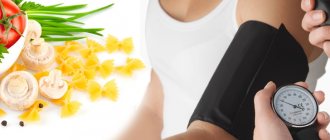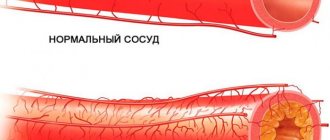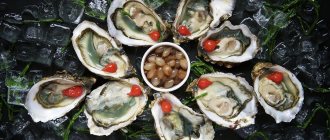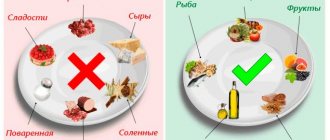People suffering from low blood pressure do not need to follow a strict diet. Fresh, high-quality products and split meals (4-6 times a day) are quite enough for good health.
The diet must include foods such as eggs, legumes, vegetables, fresh herbs, seafood, as well as nuts, liver, chicken, veal, prunes, hard cheese, chocolate and seeds.
It is necessary to increase in the daily diet the proportion of foods that contain vitamins P, C, group B and minerals important for the health of the vascular wall:
- vegetables (cabbage, zucchini, carrots, beets, eggplant);
- porridge (rice, buckwheat, oatmeal);
- sea fish;
- fruits (apricots, citruses, black currants).
If a hypotensive person does not have stomach problems, then hot seasonings can be used when cooking: pepper, ginger, tarragon and coriander.
It is recommended to exclude from the menu such categories as semi-finished products and sugar, as well as highly processed products containing large amounts of preservatives and other additives.
Sour apple varieties will be a real boon for good health. If there is no allergic reaction to honey, then you can eat 1 teaspoon 2 times a day.
What to drink if you have low blood pressure?
The drinking regime for hypotensive patients remains the same as for people with normal blood pressure: 30 ml per 1 kilogram of weight.
There is a common belief that hypotensive people need to drink as much coffee as possible. However, this drink is recommended in an amount of no more than two cups per day, excluding its use on an empty stomach. We are talking only about natural freshly brewed ground coffee. Instant drinks have little in common with coffee beans, so cardiologists do not recommend their use to anyone.
You can introduce such tasty and healthy drinks into your diet as juices (grape, carrot, grapefruit), green, black and white tea, dry red wine and cocoa.
Diet and nutrition for high blood pressure and hypertension
Diet and proper nutrition for high blood pressure and hypertension are an integral part of the treatment of this disease. In most cases, high blood pressure can be reduced without resorting to pills - just by changing some of your habits and diet.
First. If you suffer from hypertension, you need to switch to a dairy-plant diet at least temporarily. Especially if you have high diastolic blood pressure .
Note from Dr. Evdokimenko.
Diastolic pressure is the lower pressure, that is, the second digit in the indicator. Let's say if your blood pressure is 130/80, then the top reading, 130, is the systolic pressure. And the lower figure, 80, is diastolic pressure. So, it is advisable for those who have high diastolic pressure, above 100-110 units, to follow a dairy-vegetable diet.
What is meant by this diet? Everything is very simple. Less meat, especially fatty meat. Less fatty fish. Although you can sometimes afford fatty sea fish - it contains fats that are beneficial for metabolism.
If possible, exclude fried, spicy, smoked foods, as well as sweets and baked goods from your diet. That is, almost everything is delicious.
But what is possible?
All types of vegetables are allowed, in any form - stewed, boiled, steamed. Those vegetables that are eaten raw can, of course, be eaten raw.
The diet must include fruits and berries. Porridges are healthy - buckwheat, oatmeal, rice. They need to be alternated. Wholemeal bread is healthy. And any low-fat dairy products.
Bran is very useful (they are generally useful for all forms of hypertension).
The only meat that is healthy is chicken, and even then boiled. And before cooking, be sure to cut off all visible fat from it.
You ask me: why endure such dietary restrictions?
First of all, for the sake of survival, since high diastolic pressure can lead to heart attacks and strokes.
To complete the dietary topic, let's create a sample menu for a person with hypertension. So.
Ideal lunch for hypertensive patients:
The main dish (for satiety) is chicken breast. The breast can be replaced with a small amount of fish to compensate for the lack of potassium in the body. Choose what you like best - cod, hake or mackerel.
Garnish: baked jacket potatoes + seaweed. Or bean lobio. Or buckwheat. Or boiled rice. Or vegetables (in any form). Tomatoes, beets, radishes, and green onions are very useful.
For dessert - dried fruits: apricots, dried apricots, prunes, raisins. Or fresh fruits and berries - currants, grapes, apricots, peaches.
We wash it all down with water or tea, but best of all, compote or fruit drink. Just not purchased, but prepared yourself, at home. The best option is blueberry, cranberry or lingonberry juice.
As you can see, this is not a royal dinner. But you can live.
To reduce blood pressure, you need to eliminate the deficiency of magnesium and potassium.
Very often, hypertension is caused by a lack of essential vitamins or microelements. And first of all - a lack of potassium and magnesium. Especially magnesium.
It is even sadder that many drugs for lowering blood pressure, which have a diuretic effect, accelerate the loss of potassium and magnesium by the body. But smart doctors, of whom there are very few left in nature, will try to help the patient compensate for the deficiency of potassium and magnesium in the body.
This can be done with the help of useful tablets (you will be surprised, there are such) - with the help of asparkam or panangin.
In addition, in many cases, a combination of magnesium and vitamin B6 works well for hypertension.
Read more about magnesium preparations with vitamins B6 here >>>
But if we talk about potassium, a microelement important for the heart and blood vessels, then its deficiency is best compensated with the help of potassium-containing foods.
For reference. The largest amount of potassium (more than 0.5 g per 100 grams of food) is found in dried fruits - apricots, prunes, raisins. And also in peas, beans, seaweed. And in potatoes, especially baked ones in their jackets.
Relatively large amounts of potassium (up to 0.4 g per 100 grams of food) are found in cod, hake, mackerel, oatmeal, tomatoes, beets, radishes, green onions, currants, grapes, apricots and peaches. And also in beef and pork.
Slightly less potassium (about 0.25 g per 100 grams of food) is found in chicken, pike perch, millet, buckwheat, carrots, zucchini, pumpkin, strawberries, pears, plums and oranges.
We follow the water regime - drink water in the right quantities.
In observations of the majority of hypertensive patients, it was noticed that they drink any drinks - tea, coffee, beer, packaged juices, but drink very little plain still water.
And this is bad, because only plain water properly cleanses the kidneys and helps the kidneys remove various toxins and waste products from our body from the body. Coffee and beer, on the contrary, hinder the functioning of the kidneys; and juices and teas most often do not provide the “flushing” effect that ordinary still water can provide.
- But what do the kidneys have to do with it? - some readers will ask me. — Why did we talk about the fact that they need to be washed? We're not talking about kidneys, we're talking about blood pressure?
If you remember our conversation about the causes of hypertension, then remember that some kidney diseases lead to hypertension. In general, even the slightest deterioration in the condition of the kidneys can lead to a persistent increase in blood pressure. Therefore, the kidneys need to be helped, they need to be “flushed”, and you need to drink the required amount of water every day.
Question. How much water should you drink per day?
Some hotheads claim that you need to drink 2-3 liters of water per day. This, of course, is clearly overkill. This can also lead to water poisoning (yes, this happens). You need to drink about 1 liter of water per day—namely water, not coffee, tea, juices or beer.
If you want some other drinks in addition to water (the same teas, juices, coffee or beer), please drink them to your satisfaction, approximately at the rate of plus another liter of liquid per day. But no more.
Note from Dr. Evdokimenko. You can find out if you are drinking enough by taking a routine clinical blood test (finger prick). In this analysis there is such an indicator - hematocrit, which is often denoted by the English letters HCT.
So, if your hematocrit is elevated, you need to drink more water. And if it is low, on the contrary, you need to drink even less. However, such a decrease in hematocrit occurs quite rarely, mainly after severe bleeding and with anemia.
By the way, some hypertensive people believe that if you drink a lot of water, your blood pressure, on the contrary, will increase even more. Plus there will be swelling. Could this happen?
Certainly. But only if a person continues to consume excess salt. Salt immediately retains water in the body and increases blood pressure.
We've already talked about this here >> Remember: without reducing the amount of salt you consume, no other efforts to lower your blood pressure will help except poison (that is, pills)!
Chapter by Dr. Evdokimenko© from the book “BEING HEALTHY IN OUR COUNTRY.” All rights reserved.
READ MORE:
- All important articles about hypertension and high blood pressure
- Hypertension, arterial hypertension, high blood pressure: a very profitable disease!
- The first chapters of the book “Being healthy in our country”
- All articles by Dr. Evdokimenko
- Where to buy books by Dr. Evdokimenko
Foods that will help raise blood pressure
If your blood pressure monitoring readings are low, but not low enough to require medication, you can try to correct them with tasty and healthy foods:
- Sweet, strong tea will help with a sharp rise in blood pressure. You can drink it with a sandwich (bread, butter and hard cheese).
- Grind the roasted coffee beans, about 50g, and add 500g of honey. Add fresh juice of 1 lemon and stir well. Keep the finished mixture in a glass container in the refrigerator. Take 1 teaspoon an hour after breakfast.
- Ginger has a mild tonic effect. Dissolve 1/2 teaspoon of ginger powder in 250 ml of tea (strong and sweet). For 7 days, drink 1 glass of this drink, divided into 3 doses.
- Salt helps raise blood pressure - seeds, nuts, cucumbers. However, you should not abuse them, putting an excessive burden on the kidneys.
Any of the proposed methods requires moderation from the patient. It is also necessary to remember that the problem of hypotension cannot be solved with diet alone. Timely consultation with a specialist and regular use of prescribed medications are necessary.
Symptoms of arterial hypotension
Physiological hypotension usually does not cause any discomfort. In the acute form of the disease, oxygen starvation of the brain tissue is observed, which is why the patient suffers from:
- short-term visual impairment;
- dizziness;
- unsteady gait;
- fainting.
His skin becomes pale. The main symptom of orthostatic hypotension is a sharp deterioration in well-being when the body position changes from horizontal to vertical (rising from a chair, bed).
Secondary hypotension, when low blood pressure is caused by another disease, manifests itself:
- drowsiness;
- weakness;
- apathy;
- tachycardia;
- violation of thermoregulation;
- memory impairment;
- increased sweating of the feet and palms;
- emotional lability;
- severe headaches;
- increased fatigue.
Also, the secondary form of hypotension can cause potency disorders.
Autonomic crises cannot be excluded in case of arterial hypotension. In most cases, they occur with hypothermia, adynamia (loss of strength), bradycardia, profuse sweating, abdominal pain, vomiting, nausea, laryngeal spasm (breathing becomes difficult).
If you notice similar symptoms, consult a doctor immediately. It is easier to prevent a disease than to deal with the consequences.
Treatment of arterial hypotension
Carrying out competent and effective treatment of hypotension is impossible without first identifying the reasons for the decrease in blood pressure. In acute forms of the disease, the following can be used:
- glucocorticoids;
- nootropics (“Piracetam”, “Glycine”)”
- adaptogens (tinctures of ginseng, lemongrass, eleutherococcus, aralia)"
- anticholinergics"
- cerebroprotectors (“Vinprocetin”, “Cinnarizine”, “Actovegin”);
- antioxidants (succinic acid);
- antidepressants;
- tranquilizers;
- vitamins (E, B, A).
Patients are also indicated for infusion of colloidal and saline solutions.
Good results in the treatment of hypotension can be achieved with tonics (tea, coffee), proper rest and exercise. You can take medications containing caffeine:
- "Algon";
- "Adolorin";
- "Accept";
- "Askofen";
- "Pentalgin-N";
- "Sedal";
- "Citramon";
- "Excedrin";
- "Trimol";
- "Saridon".
Physiotherapeutic procedures can be used in complex therapy for arterial hypotension:
- aromatherapy massage;
- massage of the cervical-collar area;
- acupuncture;
- electrosleep;
- electrophoresis on the collar area;
- exercise therapy;
- aeroionotherapy;
- aromatherapy;
- hydrotherapy (Vichy shower, circular and Scottish shower, mineral and aromatic baths).
What to do if your blood pressure drops sharply?
In addition to consuming any of the foods and drinks mentioned above, these simple tips can help raise your blood pressure:
- You need to lie down with your legs raised or sit down with your feet on a stand, and then put your head between your legs (stay in this position for several minutes).
- It is useful to open the windows and breathe in fresh air.
- Drink a glass of water.
- Eat a snack or something sweet.
Video: What foods increase blood pressure
4.83 Aug. rating ( 95 % score) – 6 votes – ratings
Complications
The disease can cause the following complications:
- loss of consciousness;
- hypotensive crisis;
- collapse and shock;
- increased risk of stroke and heart attack.
If the tone of the stomach, intestines or gall bladder decreases, pathologies of the gastrointestinal tract, digestive disorders, and intestinal obstruction may occur.
The danger of muscle hypotonia in newborns is that the child will begin to develop later (hold his head, grasp objects, walk), the growth of bones and muscles will slow down, and disturbances in the formation of the skeleton are possible.
Symptoms
Arterial hypotension is characterized by a decrease in blood pressure. If the numbers decrease by 20% or more from normal pressure, then tissues and organs do not receive enough nutrition from the blood. Indicators 90/60 mm Hg. Art. and below indicate the development of this pathology. The disease has acute and chronic forms.
Acute hypotension is a condition in which blood pressure drops sharply and collapse occurs. The patient urgently needs medical attention. Symptoms of acute hypotension: sudden development, lethargy, spots before the eyes, cyanosis, feeling of cold, decreased body temperature and heart rate, tremors, rapid breathing, convulsions and clouding of consciousness.
Chronic hypotension is characterized by low blood pressure for a long time. Clinical manifestations such as weakness, a feeling of cold in the upper and lower extremities, nausea, weather sensitivity, tachycardia, pain in the heart, headache, dizziness, decreased visual acuity, and a feeling of fatigue after sleep are observed.
Symptoms of muscle hypotension in children and adults include decreased muscle tone and decreased strength. Patients are not capable of prolonged physical activity and get tired quickly. Speech problems and drooling appear.
Low tone of the kidneys and bladder is accompanied by difficulty passing urine and a feeling of incomplete emptying.
A decrease in the tone of the stomach and gall bladder leads to pain, bloating, weight loss, and gastrointestinal disorders (nausea, vomiting, diarrhea, constipation, feeling of fullness). Low intestinal tone has similar symptoms.
Low uterine tone is characterized by weakening of labor.
Popular questions about hypotension
How does hypotension manifest?
Manifestations of the disease depend entirely on the type of pathology. Depending on the location (muscular, arterial, gastric, etc.) the symptoms will differ.
Why is hypotension dangerous?
The disease is dangerous due to its complications from various organs and systems.
What happens if hypotension is not treated?
Without treatment, the disease progresses. So, for example, arterial hypotension can cause a crisis, stroke or heart attack.
Causes and symptoms of hypotension
Main reasons:
- Taking analgesics, antidepressant drugs.
- Presence of arrhythmia or heart attacks.
- Dehydration of the body.
- Presence of diabetes mellitus.
- Taking diuretics or antiarrhythmic drugs.
- Presence of heart failure.
- Digestive system disorder.
- Sudden change in body position (for example, when getting out of bed)
The most common symptoms of hypotension are:
- Dizziness, blurred vision.
- Nausea and vomiting.
- Pallor.
- Chest pain.
- Fainting.
- Labored breathing.
- Headache.
- Numbness in the legs or arms.
- Feeling unstable
- Stiffness in the neck.
Causes
Causes of arterial hypotension:
- pathologies of the cardiovascular system (arrhythmia, heart failure);
- diseases of the endocrine system;
- reduction in blood volume in the body;
- anaphylactic or septic shock;
- chronic stress;
- sleep disorders.
Arterial hypotension during pregnancy most often occurs due to high levels of progesterone. This hormone relaxes blood vessels and dilates arteries. Also, the cause of signs of hypotension can be changes in the blood flow between the mother’s body and the uterus.
Muscle hypotension can occur due to:
- congenital diseases or abnormalities;
- insufficient protein intake;
- disorders of the thyroid gland;
- toxic poisoning;
- low physical activity;
- brain injuries.
With hypotension of the kidneys, the pelvis is affected, its tone decreases. This occurs due to congenital diseases, hormonal disorders, and injuries. It may occur in bedridden patients due to prolonged lying down.
Low stomach tone is caused by malnutrition, intoxication, inflammatory processes, and lack of potassium.
The reasons for decreased tone of the gallbladder are excessive consumption of fatty or fried foods, defects in the tissues of the gallbladder wall, and parasitic infestation.
Bladder hypotension occurs due to trauma, pregnancy, neoplasms or stones, inflammatory processes, and also due to prolonged urinary retention.
A decrease in intestinal tone occurs due to regular stress, circulatory disorders, congenital diseases or non-compliance with the diet.
Low uterine tone can occur due to developmental defects, scarring, or after multiple births.
Drug-induced hypotension occurs due to excessive dosage of diuretics, vasodilators and psychotropic drugs, drugs for arrhythmia and ischemia.
Diagnostics
Diagnosis begins with a medical history and blood pressure measurement. Sometimes it is necessary to monitor blood pressure readings throughout the day or week. Ultrasound, ECG and laboratory tests are prescribed: general urinalysis, general and biochemical blood tests.
When diagnosing low muscle tone, additional methods are used - recording the electrical activity of muscles (electromyography), MRI, CT.
When diagnosing decreased tone of the gallbladder and intestines, duodenal intubation or colonoscopy is used.
To confirm pathology in the bladder, cystoscopy, pyelography, and urethrocystography are performed.
Hypotension
Hypotension is a state of decreased tone. Affects various organs and systems of the body. There are several types of pathology: hypotension of muscles, stomach, kidneys, intestines, uterus, gall and bladder, cardiac, drug and arterial hypotension. Regardless of the location and type of hypotension, it entails functional impairment. In medical practice, the most common types of pathology are arterial and muscular. The ICD-10 code for arterial hypotension is I95, muscular hypotension is P94.2.









